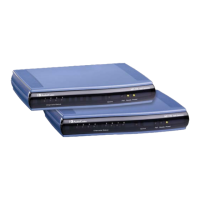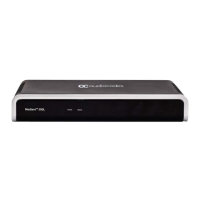User's Manual 30 Document #: LTRT-27045
Mediant 1000B Gateway & E-SBC
The main configuration entities and their involvement in the call processing is summarized
in following figure. The figure is used only as an example to provide basic understanding of
the configuration terminology. Depending on configuration and network topology, the call
process may include additional stages or a different order of stages.
Figure 1-2: SBC Configuration Terminology for Call Processing
1. The device determines the SIP Interface on which the incoming SIP dialog is received
and thus, determines its associated SRD.
2. The device classifies the dialog to an IP Group (origin of dialog), using a specific
Classification rule that is associated with the dialog's SRD and that matches the
incoming characteristics of the incoming dialog defined for the rule.
3. IP Profile and inbound manipulation can be applied to incoming dialog.
4. The device routes the dialog to an IP Group (destination), using the IP-to-IP Routing
table. The destination SRD (and thus, SIP Interface and Media Realm) is the one
assigned to the IP Group. Outbound manipulation can be applied to the outgoing
dialog.
1.3.2 Gateway Application
The objective of your configuration is to enable the device to forward calls between the IP-
based endpoints and PSTN-based endpoints. The PSTN-based endpoints can be analog
endpoints such as FXO (e.g., PBX) or FXS (plain old telephone service or POTS) or digital
endpoints such as ISDN trunks. The IP-based endpoints (SIP entities) can be servers such
as SIP proxy servers and IP PBXs, or end users such as LAN IP phones. In the SIP world,
the endpoints are referred to as SIP user agents (UA). The UA that initiates the call is
referred to as the user agent client (UAC); the UA that accepts the call is referred to as the
user-agent server (UAS).
The following table describes the main configuration concepts and terminology.
Table 1-3: Configuration Concepts and Terminology
Configuration Terms Description
IP Groups The IP Group is a logical representation of the SIP entity (UA) with which
the device receives and sends calls. The SIP entity can be a server (e.g.,
IP PBX or SIP Trunk) or it can be a group of users (e.g., LAN IP phones).
For servers, the IP Group is typically used to define the address of the
entity (by its associated Proxy Set). IP Groups are used in IP-to-Tel and
Tel-to-IP routing rules to denote the source and destination of the call
respectively.
Proxy Sets The Proxy Set defines the actual address (IP address or FQDN) of SIP
entities that are servers (e.g., IP PBX). As the IP Group represents the
SIP entity, to associate an address with the SIP entity, the Proxy Set is

